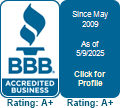
When shopping for a heating and cooling system for your residence, it’s crucial to choose one that balances efficiency, performance and budget. That’s why many homeowners use mini-splits to heat and cool their home.
Mini-splits—often known as ductless mini-splits—have a variety of advantages that make them an appealing option for both homes and businesses. They're very energy efficient, lowering energy consumption and saving on utility costs, because they don't have the energy losses affiliated with the ductwork found in traditional HVAC systems. They also permit users to control the temperature in each room, boosting overall comfort while conserving energy.
If you’re interested in mini-split installation in West Valley City, it’s worthwhile to first find out if these devices are the best fit for your living situation. Here, we’ll investigate how mini-splits compare to other heating and cooling methods.
What a Mini-Split Is and How It Works
A mini-split, or ductless mini-split, is a heating and cooling system that does not use ductwork. It's a good option in homes that don't have any air ducts and for homes with rooms that aren’t served well by the residence's existing HVAC system.
A mini-split system has two primary components: an outdoor compressor/condenser and an indoor air-handling component. These are connected by a conduit containing the power cable, refrigerant tubing, suction tubing and a condensate drain.
Here's how it works: the outside compressor circulates the refrigerant necessary for heat exchange through the coils and the air handler. The in-house unit draws in air from the room, cools or heats it over the coils and forces the conditioned air back into the room.
Mini-Split vs. Central Air
Mini-splits offer targeted cooling in particular rooms or zones of your residence. They are outstanding for energy efficiency because they only condition the areas you want. However, they may not blend seamlessly into every room because of their wall-mounted indoor units.
On the other hand, a central air system uniformly chills your entire home, producing consistent comfort levels throughout. Its ductwork is hidden away, preserving the aesthetics of your home. But it will likely not be as energy efficient as a mini-split, especially in bigger homes or residences where certain areas may not need constant conditioning.
Mini-Split vs. Window AC/Window Unit
Mini-splits are usually more energy efficient and not as loud as a window air conditioning unit and are able to cool multiple rooms. This is why mini-splits are a versatile option for lots of homeowners. They also use a kind of refrigerant that is more environmentally safe, reducing their environmental impact. These devices can even add value to your home due to their durable nature and exceptional cooling capabilities. However, they come with a larger initial investment.
On the other hand, window air conditioners are less expensive initially. They may be a good fit for homes that are not able to accommodate a central air system or for homeowners with budget constraints. In spite of these advantages, window units can utilize up to 40% more energy than ductless mini-split systems and often are louder.
Mini-Split vs. Portable AC
The answer to what is better, a ductless mini-split or a portable air conditioning unit, is dependent on your goals. If your main worries are energy efficiency and ability to quickly cool a room, a mini-split is considered far superior to a portable AC unit. However, if funding is a major concern, a portable AC costs less.
Mini-Split vs. Gas Furnace
The choice between a mini-split system and a gas furnace depends on an assortment of factors including the climate in your city, home size, energy efficiency preferences and spending plan.
A mini-split system most of the time is more energy efficient than a gas furnace. It can heat and cool targeted areas within your home, providing custom climate control in specific rooms. Mini-splits also are generally quieter and have a greater up-front cost, but their operating costs are usually smaller due to their greater energy efficiency.
Alternatively, a gas furnace can be an extremely effective heating solution, particularly in colder climates where mini-split heat pumps may fail to maintain comfort levels in the bitter cold. While they are less energy efficient than mini-splits, gas furnaces typically are not as expensive. Having said that, their operating costs can be more costly, especially if natural gas prices rise.
Mini-Split vs. Heat Pump
Mini-splits and heat pumps use the concept of heat transfer. They are both energy efficient, but a heat pump's air ducts can be less efficient. That said, the choice between a mini-split and a heat pump often depends on a family's needs and circumstances.
Case in point, if you live in a warmer climate and mainly need cooling, a mini-split system might be a good choice. But then again, if you need both heating and cooling and already have ductwork installed in your residence, a heat pump might be a more efficient option.
Mini-Split vs. Space Heater
With regards to heating and cooling a household, mini-splits and space heaters each have advantages. However, for total efficiency, versatility, comfort and safety, mini-splits outperform space heaters. Mini-splits supply superior energy efficiency because they deliver conditioned air right to different zones and can serve multiple rooms at once.
Space heaters are far less expensive to buy but are typically recommended for heating a small area or a single room. They also are often less energy efficient. As opposed to mini-splits, space heaters do not supply cooling. The greatest drawback for space heaters is the danger of fire. Authorities say some 1,700 fires per year involve space heaters.

